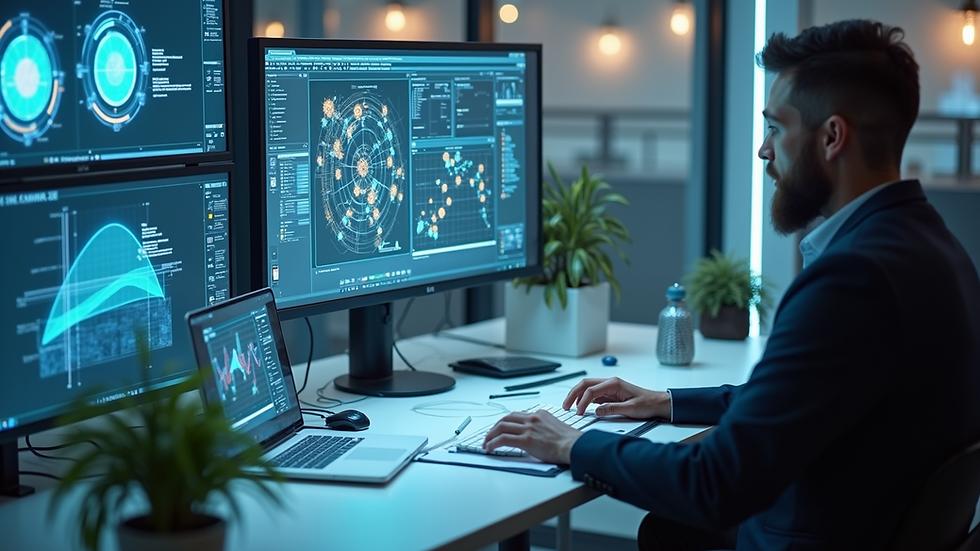Transforming Industries with Augmented Reality Applications
- Shadnam Khan

- Jun 23, 2025
- 3 min read
Augmented reality (AR) is changing the way we interact with our environment. By superimposing digital information onto the physical world, AR applications are enhancing our day-to-day experiences across various industries. This innovative technology is not just a novelty; it has practical applications that are redesigned to improve efficiency and productivity.

AR-Powered Solutions
AR-Powered solutions offer transformative potential in numerous avenues. Let’s explore how different sectors are leveraging these solutions to enhance processes, improve customer experiences, and create new opportunities.
Healthcare Revolution
In the medical field, AR is improving patient outcomes and assisting in education and training. For instance, surgeons use AR glasses to overlay digital information on the patient during surgical procedures, assisting them in visualizing complex structures and making accurate incisions.
A study found that AR can reduce errors during surgeries by up to 30%. Furthermore, medical students can use AR for immersive training sessions, allowing them to practice procedures in a controlled environment without risk to real patients.

Education Enhancement
The education sector is undergoing a significant transformation due to AR technology. Classrooms around the world are incorporating AR into their curricula to create interactive lessons that captivate students. Imagine a biology lesson where students can visualize and interact with a 3D model of a cell right in front of them.
Statistics show that students retain information better when engaging with AR content. Reports indicate that AR-enabled lessons can lead to a 70% increase in learning retention compared to traditional teaching methods. Tools like AR textbooks and educational apps are changing the paradigm, making learning more engaging and immersive.
Retail and E-commerce Innovation
In retail, AR applications are changing the way consumers shop. By allowing customers to visualize products in real-time, AR enhances the shopping experience. Imagine trying on clothes virtually or placing a piece of furniture in your home using your smartphone.
In fact, AR is estimated to drive a 10% increase in retail sales within the next few years. Major brands like IKEA have already implemented AR applications, allowing customers to see how items will look in their homes before making a purchase. This innovation builds customer confidence and minimizes the return rates of products.

What is the Difference Between VR and AR Applications?
Understanding the distinction between virtual reality (VR) and augmented reality (AR) applications is crucial for businesses considering these technologies. While both immerse users in a digital experience, their approaches vary significantly.
Virtual Reality (VR): VR creates a fully immersive digital environment, isolating users from the real world. Users typically need specialized gear like headsets to explore these virtual worlds.
Augmented Reality (AR): In contrast, AR overlays digital elements onto the real world. Users engage with their physical surroundings while interacting with digital information, making AR more accessible for various applications.
Businesses must assess their objectives carefully to choose between VR and AR, as each serves different purposes despite its immersive capabilities.
Manufacturing Efficiency
AR applications are redefining manufacturing processes. By integrating AR into production lines, companies can provide workers with real-time data and instructions. For example, technicians wearing AR glasses can receive visual cues for assembly operations, reducing assembly time and minimizing errors.
Research shows that AR can increase productivity by up to 20% on manufacturing floors. Companies utilizing AR for equipment maintenance can anticipate failures faster, decrease downtime, and enhance safety by delivering immediate data on machine health.
Construction and Architecture
The construction industry benefits immensely from AR applications. Builders and architects can use AR to visualize building designs on-site, allowing for real-time modifications and better planning. Workers can view design overlays, ensuring that installations match architectural blueprints.
Reports indicate that using AR in construction can lead to a reduction in costs by up to 15%. By catching mistakes before they become costly errors, AR applications significantly improve project efficiency and collaboration among teams.
Final Thoughts
AR technology continues to evolve, offering unprecedented solutions across various industries. As businesses recognize its potential, adoption rates are expected to soar. With advantages ranging from improved efficiency and enhanced customer experiences to significant cost savings, AR is not just a tool for entertainment—it's a game-changer for businesses ready to embrace the future.
As we continue exploring these innovative solutions, businesses must also keep an eye on developing trends. Investing in augmented reality applications could lead to competitive advantages in the coming years. Now is the time to explore how AR can be integrated into your industry for greater efficiency, improved user experience, and enhanced outcomes.




Comments